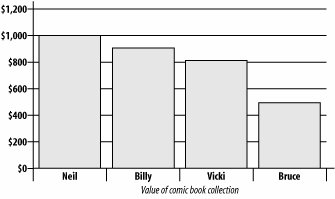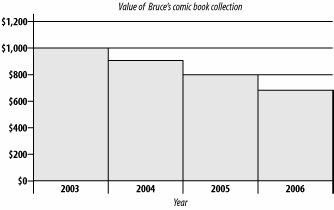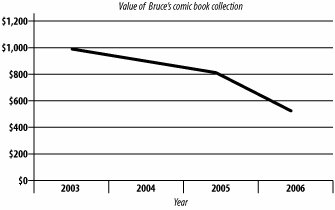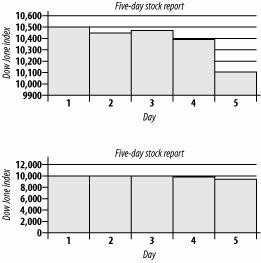Hack 22. Avoid the Axis of Evil
| Graphs are powerful tools to represent quantities, relationships, and the results of research studies. But in the wrong hands, they can be made to deceive. Choose your destiny, young Luke (or, if you are under the age of 25, "young Anakin"), and avoid the dark side. There was a time when only scientists, engineers, and mathematicians ever saw a graph. With the advent of more and more news outlets aimed at the general public, visual representations of numeric information have become more and more common. Just think of yesterday's issue of USA Todayit contained at least a dozen graphs. In business conferences, graphs are used frequently to communicate information and demonstrate success (or failure). If the creator of a graph isn't careful, though, choices that might seem arbitrary will affect the interpretation of the information. Without changing the data, you can change the meaning. So, if you want to avoid manipulating your audience when you create a graph, or if you just want to be able to spot a misleading (whether intentional or not) chart, then use this hack to help you create and interpret graphs effectively. Choosing the Honest GraphTo understand correct and incorrect graphing options, we first have to cover some graphing basics. There are various pieces to a graph, and the manipulation of those pieces can lead or mislead. Typical graphs have two axes, because they describe two different variables. Axes are the lines along the bottom, called the X-axis, and along the side, called the Y-axis.
The sort of graph that is appropriate (and nondeceptive) for showing the variables you have measured depends on the level of measurement of your variables [Hack #7]. You can choose from three common types of graphs, and only one will be the right one for your variables:
Figure 2-8. Bar chart
Figure 2-9. Histogram
Figure 2-10. Line chart To pick the right kind of graph (i.e., the one with the format that is the least deceptive and the most intuitive), identify the types of X variable you are using (notice that Y is continuous in all of these formats):
Graphic ViolenceA common error in graphing, either intentional or not, has to do with setting the scale for the X-axis. Here's why this is a problem and how you can avoid it. Graphs with two variables invite comparisons across categories or time or across different values of one variable. Pictures are worth a thousand words, as they say, and a graph can be very persuasive evidence. Anytime lines or bars are used to compare values, the comparison is accurate only when the height of the line or the length of the bar is judged against some standard minimum value. That minimum value is often zero. If the graph is not calibrated to some reasonable base value, small differences look huge. Compare the two graphs shown in Figure 2-11, for example. Both convey exactly the same data, and yet your interpretation of each might be wildly different. The histogram in the top left reflects performance of the U.S. stock market over the last five days. Notice a rather frightening-looking drop on day five. No doubt, earth-shaking news hit near the end of day 4. You might also notice that the Y-axis (the Dow Jones Index) does not begin at zero; it begins at 9,900, a value that is low enough to contain the top of all five bars, but that is otherwise not meaningful. Figure 2-11. The power of the Y-axis Look more closely at the second histogram in Figure 2-11, on the bottom right. Both charts present the same data, but the second graph uses zero as the starting point. The interpretation of the data as presented in this graph shows very little fluctuation across the last five days, and the frightening drop at day 5 is barely a hiccup. Which display is the correct one? Both reflect a drop of 2.8 percent in stock market value from day 4 to day 5. It really depends on the intent of the graph constructor and the intended audience. When number counts are involved, or money, the most meaningful and fairest starting point is usually nothing. Many newspapers provide daily stock information in the format as shown in the first histogram. They believe their readers are interested in small changes, so they set a Y-axis starting value that is as high as possible but low enough to contain all data points on the X-axis. After all, to an avid investor who changes her portfolio often and buys and sells frequently, a drop of 2.8 percent is serious business. A graph designed to make small changes look serious might be the most valid for that reader. If an investor is one of those "in it for the long haul" types, a relatively small change is meaningless, however. To get the most meaning out of graphs like these, always check the bottom value on the Y-axis. This way, you can get a sense of the real differences on the X-axis as you crawl from bar to bar. If you are making graphs like these, think about the most honest way to present the information. You want to inform, not deceive (probably). See Also
|
EAN: 2147483647
Pages: 114
